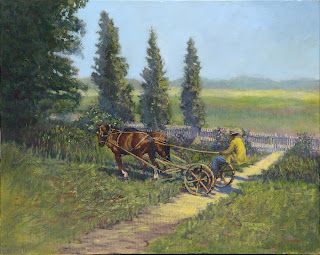18x24 Acrylic on panel, © 2014
Private Collection
There are always firsts. This was a first for horses. Well, almost a first. I sat by Antonio, a Native American, in third grade. He was great at drawing horses, and I always envied his ability. Later I entered a "contest" on the "Sheriff Dan Show" and won a sewing machine for my grandmother. But I'll not count those as horses that would compare with this endeavor. After watching horse pulls for hours, researching horse anatomy, and harnesses, I made the attempt. Dress harnesses are not the run of the mill harness, as they are much fancier and for show.
I have always admired horses, even before the third grade. Draft horses are powerful athletes and responsive to the occasion and the teamster. These horses have "performed" and are now pulling the owner, Parley, around the arena which has the purpose of settling them down after the Adrenalin rush of the pull. You can see the power in the arms of the man and can hear the loud speaker host announce the next event. What a great day for a pull.
The challenge of the painting was to have the sense of place not take away from the horses and man. They must remain supporting characters in the display—seeing into shadows and feeling the power and desire of the horse and master, so that the spirit of the event is present.
The meaning of the painting is expressed best here:
From “Why I don’t call myself a ‘Mormon feminist,’” Deseret News, March 26, 2015
…“Marriage in the temple was another reminder that we can’t receive every celestial blessing on our own. My new vulnerability was ultimately like closing the proverbial umbrella to receive a shower of heavenly blessings that sometimes even drenched and always sustained.
“Temple ordinances taught me that my husband needed me, and I needed him, and we both needed the Savior to succeed. Those truths parallel to daily drudgeries as well. When we don’t work as a team and when we don’t turn to God for guidance, our finances are a mess, we are less-than-our best in our careers and our children exploit any semblance of a divide. The opposite has proven to be true—not any easier, but true, nonetheless.
“My wise father grew up on a farm in southeastern Idaho where his father trained Clydesdale horses. His favorite parable for marriage is a team of horses that can’t move forward unless they are walking side-by-side and equally yoked. He also frequently counseled me, and many others, that marriage isn’t 50/50, but each must give a 100 percent in order to succeed.
“Last Christmas, my dad commissioned a painting of his father holding the reins of his draft horses during a horse-pulling competition at the fairgrounds. Every time I walk past the print my parents gave each of their children, I remember to share the yoke. But I’m also reminded how the Savior holds the reins and gives us gentle reminders when we stray from a progressive path.” —Stacie Duce (Parley's granddaughter)





















